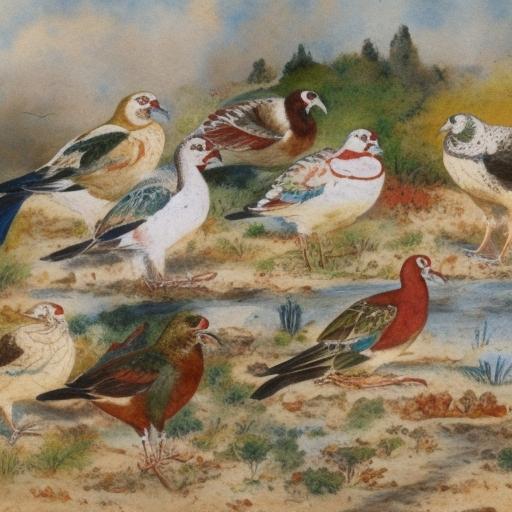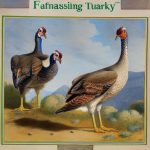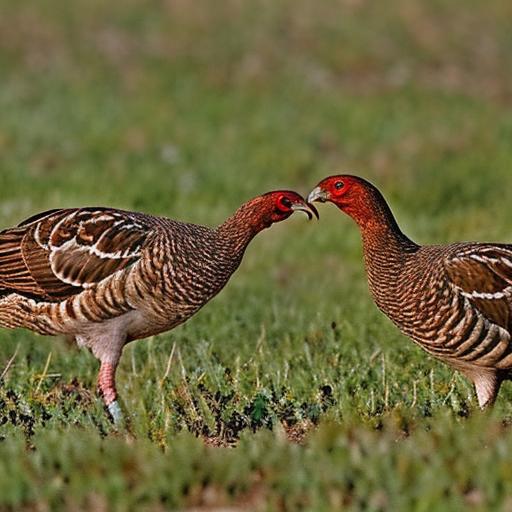Turkey breeds have been an integral part of human civilization for centuries, providing a valuable source of meat, eggs, and feathers. There are various breeds of turkeys, each with its own unique characteristics and traits. These breeds can be categorized into heritage breeds, commercial breeds, and rare breeds, each serving different purposes and having distinct qualities. In addition to domesticated turkey breeds, there are also wild turkey subspecies that play a crucial role in the ecosystem. The conservation of turkey breeds is essential to preserve genetic diversity and ensure the survival of these magnificent birds for future generations.
Key Takeaways
- Turkey breeds have been developed for different purposes such as meat production, egg production, and exhibition.
- Heritage breeds of turkey are traditional breeds that have been raised for generations and are valued for their unique characteristics and historical significance.
- Commercial breeds of turkey are developed for efficient meat production and are commonly used in the turkey industry.
- Rare breeds of turkey are at risk of extinction and efforts are being made to preserve and promote these breeds.
- Wild turkey subspecies are native to North America and have distinct characteristics and behaviors.
Heritage Breeds of Turkey
Heritage turkey breeds are traditional breeds that have been raised by farmers for generations. These breeds are known for their rich flavor, superior texture, and ability to thrive in free-range environments. Some popular heritage turkey breeds include the Bourbon Red, Narragansett, and Standard Bronze. These breeds are prized for their ability to forage for food and their natural mating instincts, which make them well-suited for sustainable farming practices. Heritage turkey breeds are often raised on small farms and are valued for their unique appearance and historical significance. They are an important part of agricultural heritage and play a vital role in preserving genetic diversity within the turkey population.
On the other hand, heritage turkey breeds are also known for their slower growth rate and smaller breast size compared to commercial breeds. Despite these differences, many people prefer the taste and texture of heritage turkey meat, which is often described as more flavorful and succulent. In recent years, there has been a resurgence of interest in heritage turkey breeds as consumers seek out more natural and sustainable food options. As a result, efforts to conserve and promote heritage turkey breeds have gained momentum, with organizations dedicated to preserving these traditional breeds and educating the public about their importance.
Commercial Breeds of Turkey
Commercial turkey breeds are specifically bred for mass production and are commonly raised on large-scale farms for meat production. These breeds are selected for their rapid growth, high feed conversion efficiency, and large breast size, which are desirable traits for the commercial market. Some popular commercial turkey breeds include the Broad Breasted White and Broad Breasted Bronze, which have been developed through selective breeding to meet the demands of the modern poultry industry. Commercial turkey breeds are typically raised in controlled environments and are often fed a specialized diet to maximize growth and minimize production costs.
Commercial turkey breeds have played a significant role in meeting the growing demand for turkey meat around the world. Their ability to reach market weight quickly and efficiently has made them a staple in the poultry industry. However, the focus on productivity and uniformity has led to concerns about genetic diversity and the welfare of these birds. As a result, there has been increasing interest in promoting alternative production systems that prioritize animal welfare and environmental sustainability. While commercial turkey breeds continue to dominate the market, there is a growing movement towards supporting more ethical and sustainable methods of turkey production.
Rare Breeds of Turkey
Rare turkey breeds are lesser-known breeds that are at risk of extinction due to declining population numbers and limited genetic diversity. These breeds often have unique characteristics and historical significance, making them valuable for conservation efforts. Some rare turkey breeds include the Royal Palm, White Holland, and Slate, which are prized for their distinctive color patterns and ornamental qualities. Despite their rarity, these breeds play an important role in preserving genetic diversity within the turkey population and are cherished by enthusiasts for their unique attributes.
Rare turkey breeds face numerous challenges, including competition from commercial breeds, limited breeding populations, and lack of public awareness. Efforts to conserve rare turkey breeds involve raising awareness about their value, promoting responsible breeding practices, and establishing breeding programs to increase population numbers. Organizations dedicated to rare breed conservation work tirelessly to ensure the survival of these unique turkey breeds for future generations. By supporting rare breed conservation efforts, individuals can contribute to the preservation of genetic diversity and help safeguard the future of these remarkable birds.
Wild Turkey Subspecies
Wild turkey subspecies are native to North America and play a crucial role in maintaining ecological balance within their natural habitats. There are six primary subspecies of wild turkeys, each with its own distinct range and characteristics. These subspecies include the Eastern wild turkey, Osceola wild turkey, Rio Grande wild turkey, Merriam’s wild turkey, Gould’s wild turkey, and the Ocellated wild turkey. Wild turkeys are known for their agility, keen senses, and ability to thrive in diverse environments, from forests and grasslands to mountainous regions.
Wild turkeys have faced numerous challenges over the years, including habitat loss, hunting pressure, and competition from non-native species. Conservation efforts for wild turkey subspecies focus on habitat restoration, predator management, and sustainable hunting practices to ensure their long-term survival. The reintroduction of wild turkeys into suitable habitats has been a key strategy in restoring their populations in areas where they were once abundant. By protecting wild turkey subspecies and their habitats, conservationists can help maintain healthy ecosystems and preserve the natural heritage of these iconic birds.
Conservation Efforts for Turkey Breeds

Conservation efforts for turkey breeds are essential to safeguard genetic diversity and ensure the long-term survival of these magnificent birds. Organizations dedicated to turkey breed conservation work tirelessly to raise awareness about the importance of preserving traditional breeds, promoting responsible breeding practices, and supporting sustainable farming methods. Conservation programs often involve establishing breeding populations, maintaining genetic registries, and providing resources for breeders to help maintain healthy populations of heritage and rare turkey breeds.
In addition to domesticated turkey breeds, conservation efforts also focus on protecting wild turkey subspecies through habitat preservation, predator management, and sustainable hunting practices. The conservation of wild turkeys is crucial for maintaining healthy ecosystems and preserving biodiversity within their natural habitats. By supporting conservation efforts for both domesticated and wild turkey breeds, individuals can contribute to the preservation of genetic diversity and help ensure the survival of these remarkable birds for future generations.
The Importance of Preserving Turkey Breeds
In conclusion, the preservation of turkey breeds is essential for maintaining genetic diversity, promoting sustainable agriculture, and preserving cultural heritage. Heritage turkey breeds play a vital role in sustainable farming practices and are valued for their unique qualities and historical significance. Commercial turkey breeds have contributed to meeting the demand for turkey meat but have also raised concerns about genetic diversity and animal welfare. Rare turkey breeds face challenges but are cherished for their distinctive traits and ornamental qualities.
Wild turkey subspecies are native to North America and play a crucial role in maintaining ecological balance within their natural habitats. Conservation efforts for both domesticated and wild turkey breeds are essential to ensure their long-term survival. By supporting conservation programs, individuals can contribute to preserving genetic diversity and safeguarding the future of these magnificent birds. The conservation of turkey breeds is not only important for agricultural sustainability but also for maintaining healthy ecosystems and preserving cultural heritage for future generations.
If you’re interested in learning about different breeds of turkeys, you might also want to check out this informative article on chicken coop interior ideas. Understanding the various turkey breeds and their unique characteristics can help you create a suitable environment for them within your coop.
FAQs
How many breeds of turkey are there?
There are six primary breeds of turkey recognized by the American Poultry Association: Bronze, Narragansett, White Holland, Black, Bourbon Red, and Beltsville Small White.
Are there other breeds of turkey not recognized by the American Poultry Association?
Yes, there are other breeds of turkey that are not officially recognized by the American Poultry Association, such as the Royal Palm, Slate, and Midget White.
What are the differences between the different breeds of turkey?
The different breeds of turkey vary in terms of size, coloration, and specific physical characteristics. For example, the Bronze turkey is known for its metallic sheen, while the White Holland turkey is predominantly white in color.
Do different breeds of turkey have different purposes?
Yes, different breeds of turkey are often bred for specific purposes. For example, the Broad Breasted White turkey is commonly raised for meat production, while the Bourbon Red turkey is known for its suitability for both meat and exhibition purposes.
Are all breeds of turkey suitable for backyard farming?
While some breeds of turkey are better suited for commercial production, many breeds can be successfully raised in a backyard farming setting. It’s important to research the specific needs and characteristics of each breed before deciding which is best for a backyard farm.
Meet Walter, the feathered-friend fanatic of Florida! Nestled in the sunshine state, Walter struts through life with his feathered companions, clucking his way to happiness. With a coop that’s fancier than a five-star hotel, he’s the Don Juan of the chicken world. When he’s not teaching his hens to do the cha-cha, you’ll find him in a heated debate with his prized rooster, Sir Clucks-a-Lot. Walter’s poultry passion is no yolk; he’s the sunny-side-up guy you never knew you needed in your flock of friends!







